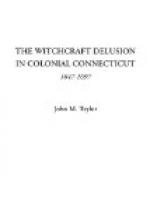A pathetic incident attaches to this case. A child to this poor woman was “borne in the prison,” who was bound out until he became twenty-one years of age, to Nathaniel Rescew, to whom L15 were paid according to the mother’s promise to him, he having engaged himself “to meinteine and well educate her sonne.” Colonial Records of Connecticut (I,143: 171: 209-22-26-32).
THE FIRST EXECUTION FOR WITCHCRAFT IN NEW ENGLAND
A secret long kept made known—Winthrop’s journal entry probably correct—Tradition and surmise make place for historical certainty—The evidence of an eyewitness—A notable service.
ALSE YOUNG. Windsor, 1647.
“May 26. 47 Alse Young was hanged.” MATTHEW GRANT’S Diary.
“The first entry (the executions of Carrington and his wife being next mentioned) supplies the name of the ’One (blank) of Windsor arraigned and executed at Hartford for a witch’—the first known execution for witchcraft in New England. I have found no mention elsewhere of this Alse Young.” J. HAMMOND TRUMBULL’S Observation on Grant’s Entry.
“Who then was the ‘witch’ with whose execution Connecticut stepped into the dark shadow of persecution? She has been called Mary Johnson, but no Mary Johnson has been identified as this earliest victim. Whose is that pathetic figure shrinking in the twilight of that early record? We could think of her with no less kindly compassion could we give a name to the unhappy victim of the misread Word of God, who was led forth to a death stripped of dignity as of consolation: who to an ignorance and credulity, brought from an old world and not yet sifted out by the enlightenment and experience of a new, yielded up her perhaps miserable but unforfeited life. Here is the note which in all probability establishes the identity of the One of Windsor arraigned and executed as a witch—’May 26, 47 Alse Young was hanged.’” "One Blank” of Windsor (Courant Literary Section, 12, 3, 1904), ANNIE ELIOT TRUMBULL.
Matthew Grant came over with the Dorchester men from the Bay Colony in 1635, and settled in Windsor, Connecticut, where he lived until his death there in 1683.
He was a land surveyor, and the town clerk, a close observer of men and their public and private affairs, and kept a careful record of current events in a “crabbed, eccentric but by no means entirely illegible hand” during the long years of his sojourn in the “Lord’s Waste.”
It has been surmised for several years—but without confirmation—and credited by the highest authorities in Connecticut colonial history, and known only to one of them, that Grant’s manuscript diary contained the significant historical note as to the fate of Alse Young. It waited two centuries and more for its true interpreter, as did Wolcott’s cipher notes of Hooker’s famous sermon, and there it is, “not made on the decorous pages which memorize the saints,” Brookes, Hooker, Warham, Reyner, Hanford, and Huit, “but scrawled on the inside of the cover, where it might be the sinner might escape detection.”




